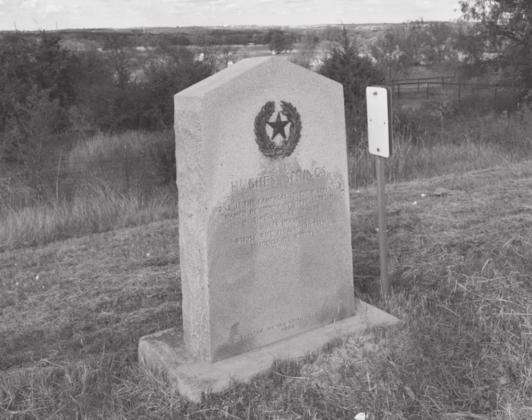About a half-dozen Texas Historical Commission state historical markers dot U.S. Highway 190 in Lampasas County. If you don’t have time to stop for them on your commute, read about them here.
Descriptions are paraphrased from the text on the markers.
C.S.A. SALT WORKS
Lampasas County’s westernmost marker on U.S. Highway 190 is C.S.A. Salt Works. The plant was located west of the marker on the Colorado Brine Springs, which Native Americans used as an infirmary or health resort.
C.S.A. Salt Works increased production during the Civil War to supply Army soldiers, cavalry horses and mule teams. The plant also prepared salt for household and ranch use.
Horses driven in a circle powered a lift that pumped brine from the spring and filled troughs placed on a 40-foot-high scaffolding. Cedar boughs in the troughs concentrated the brine, which ran into iron kettles. Boiling 50 bushels of brine produced one bushel of brine.
PHANTOM HILL ROAD
The first road in Lampasas County once crossed the current path of U.S. 190. The road connected Fort Phantom Hill, near present-day Abilene, and military headquarters in Austin.
In 1851 and 1852, the Army built seven forts between the Red and Rio Grande rivers to protect remote settlements in the area and travel routes to California. Fort Phantom Hill was established Nov. 14, 1851 by Col. J.J. Abercrombie.
Phantom Hill Road was a vital transportation and communication route used primarily by the Army, until the Army abandoned Fort Phantom Hill in 1854. Supply trains of up to 24 wagons drawn by mules, horses and oxen used the road to deliver supplies to Fort Phantom Hill.
Early settlers used the road, too, until shortly after the Civil War, when traffic was diverted to the Senterfitt Stage Station a mile-and-a-half southwest.
SCHOLTEN RAILROAD
The Scholten Brothers’ Cedar Company, owned by Dutch brothers Edward and Alfred Scholten, operated a 25-mile narrow-gauge railroad from Lometa to San Saba County. The company’s headquarters were located 100 miles west of U.S. 190’s route.
The railroad line was used to haul cedar posts and piling to the Santa Fe line in Lometa, which transported the materials to rapidly developing western Texas. The Scholten Railroad employed 500 workers.
PLEASANT VALLEY FARMERS’ ALLIANCE NO. 1
John R. Allen founded the Texas chapter of the Farmers’ Alliance in 1877 on Donaldson Creek in a “rawhide” (rough) lumber school. Its purpose was to improve ruinous farm living and economic conditions.
Two of the chapter’s secret officers, or “Grand Smokies,” tracked missing livestock.
Chapter members crusaded for and became influential in the National Agrarian Reform Movement of the era. In 1887, 3,000 sub-alliances merged with the Farmers’ Union and promoted the rise of the pro-agrarian Populist Party in the 1890s. By 1900, they had died out.
HUGHES’ SPRINGS
Just east of the U.S. 190 intersection with Fourth Street is Hughes’ Springs, named after the first settler in the area, Moses Hughes.
Hughes settled near present-day Lampasas in 1853, and his wife regained health in the waters of the springs.
BATTLE BRANCH
The Battle Branch of Sulphur Creek was named for an event in the Horrell Higgins feud of the 1870s. On the morning of March 26, 1877, Tom and Mart Horrell were ambushed by gunmen while on their way to attend district court.
The Horrells returned fire, and the attackers retreated. Mart took Tom, who was injured in the altercation, to a nearby residence and continued to Lampasas to seek help. A squad of Texas Rangers followed him to the site, but they were unable to catch the attackers.
Many believed the Higgins family led the ambush and the Horrell-Higgins feud continued for several months, involving additional gunfighting.


